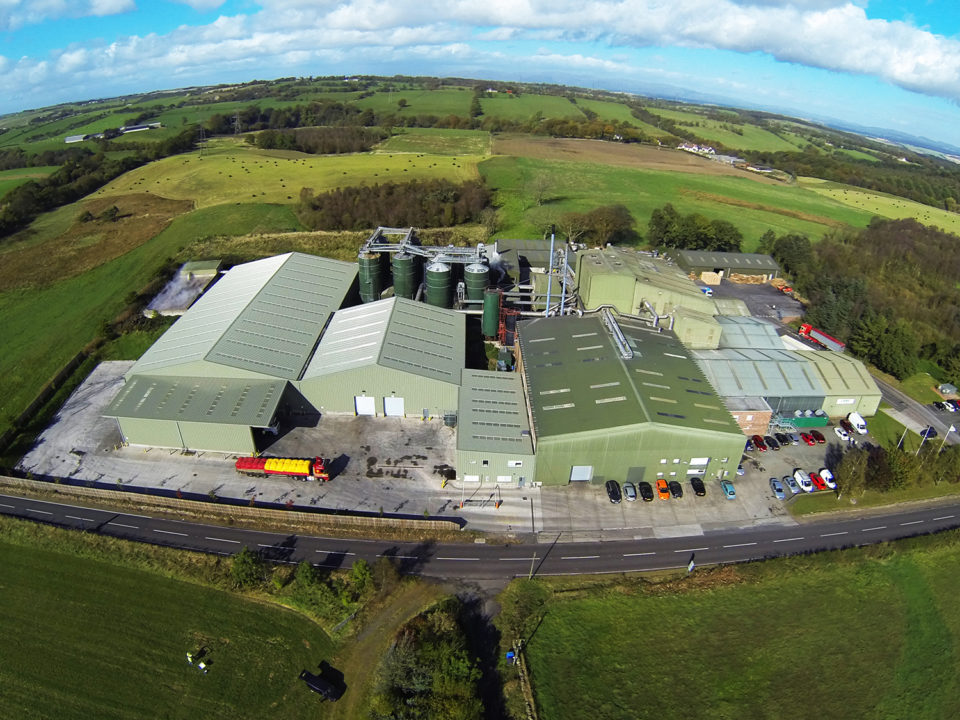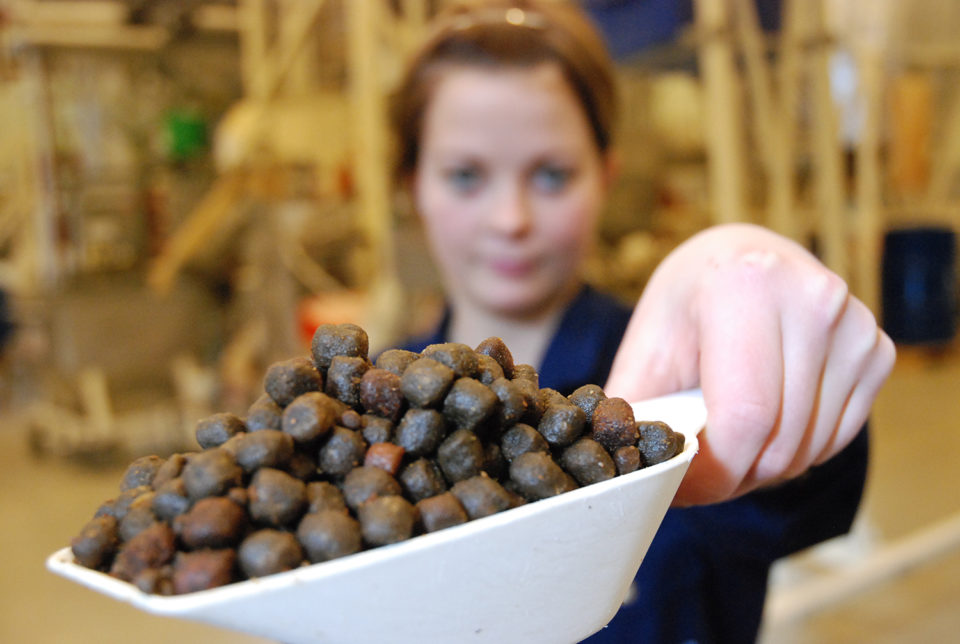Feed giant sees ‘oceans of opportunity’ with fish and shrimp farming

Cargill Aqua Nutrition (CQN), one of the world’s largest aquafeed companies, recently invited the Advocate to tour the Westfield aquafeed plant in Scotland to see how its salmon feed is produced and to learn what the future holds for the industry.
Formed in 2015, following Cargill’s acquisition of salmon feed specialist EWOS to complement its own warm-water aquaculture feed business, CQN produces feed for salmon, tilapia and shrimp in 20 countries around the world.
In 2016, Cargill produced 931,000 metric tons (MT) of salmonid feed and 810,000 MT of warm-water feeds and anticipates good growth in this sector over the next decade.
Growing demand for aquafeeds
To put this into context, global aquaculture production is expected to reach 102 million MT by 2026, according to the United Nations’ Food and Agriculture Organization (FAO). That would represent an expansion of one-third on today’s figures and far exceed the quantity produced from wild fisheries. The global aquaculture market is also expected to continue growing at 4 to 5 percent annually over the next decade, feeding the demand for increased production of aquafeeds.
With growth comes increasing concern about the long-term sustainability of aquaculture, in terms of both production and feed supplies.
Marine ingredients have played a vital part in the development of aquafeeds, but today there is a limited quantity of these that can be sourced sustainably. To address this, aquafeed companies like Cargill are identifying an increasingly wide basket of non-marine ingredients to incorporate into feed, as well as working with marine ingredient suppliers to improve the sustainability of their fisheries.
Dave Robb, CQN sustainability manager, said that producing salmon feed for the Scottish industry is a complex business, as the main salmon farming companies grow to different specifications and certifications including organic, Label Rouge, GlobalGAP, Whole Foods and Aquaculture Stewardship Council (ASC), with some companies also considering Best Aquaculture Practices (BAP). All of these standards have different specifications for fishmeal and fish oil inclusion.
Cargill has been meeting the challenge through intense R&D at the company’s innovation centers in Norway and Chile. The company has placed a strong emphasis on improving feed formulations that support fish health, meet the long-chain omega-3 fatty acid needs of fish and consumers, and reduce the reliance on forage fish. Part of the solution has also been a greater focus on incorporating trimmings from fish processing.
“We rely on a high degree of replacement ingredients in aquafeed, which means that over the past 10 years or so, our total use of fishmeal has remained relatively stable, but we have been able to substantially increase the volume of feed produced,” said Robb.
Increased use of proteins and oils from plants, along with novel ingredients, have been a major driver in reducing the inclusion of marine ingredients. The reduction of fish oil in salmon aquafeed is trickier, as it is this component that provides the high content omega-3 fatty acids required by cold-water fish, which is more difficult to replace with plant oils.

“One of the most important factors for any feed ingredient is digestibility. This, combined with nutritional content, has to be assessed for between 15 and 20 ingredients in each recipe. Consideration is also critical as to whether all components work well together to provide the required outcome, which is to grow safe, healthy fish, with optimized growth rates and a low feed conversion ratio,” said Robb.
He explained that sustainability for Cargill encompasses a wide range of factors, including full traceability and transparency through the supply chain, sustainability of raw materials, food safety and human rights, as well as an emphasis on lowering energy and water use and reducing emissions at their processing plants.
In 2016, 90 percent of marine raw materials used in EWOS-branded feeds were certified to the IFFO (The Marine Ingredients Organisation) RS Global Standard for Responsible Supply (IFFO RS standard) and Robb said that this had risen to 100 percent in 2017, if fishery improvement programs to these standards are included.
Soy is also a raw material that receives attention, and all of the soy used in EWOS-branded feeds from Norway and Scotland are certified by ProTerra, proving they were derived from farms with high sustainability credentials.
“Over the past few decades, we have also improved our sourcing of raw materials to reduce the level of contaminants such as PCBs and dioxins to around 16 percent of the maximum allowed in feed. This means that amounts reaching the fish are well within legislated limits, which is great news for people who love eating fish,” said Robb.
Cargill’s aim to respond to the wider needs of farmers and their fish has led to the development of a range of feeds. For example, functional feed that supports fish health, especially through challenging times such as smolt transfer, sea lice treatment and outbreaks of disease, represent more than one-third of sales in Scotland, and one-quarter globally.
Robb believes that one of Cargill’s key strengths is COMPASS, which is an approach to feed design that takes several important considerations into account to help fish farmers achieve the best profit margins per site.
“One size does not fit all, since sea water temperature in the north and south of Norway can differ between 3 and 13 degrees-C in May alone. Diets based on COMPASS are adapted to local conditions, which in turn helps salmon farmers to manage their production better, whatever the location or season. Having this option for farmers strengthens the bond between us and has helped Cargill to develop longer term, more sustainable relationships,” said Robb.
The mechanics of producing feed
Salmon feeds are some of the most nutrient-dense feeds of any farming system, but the precision behind Cargill’s feed production surprises many people – even those in the industry, according to Robb.
“The Westfield factory operates two production lines, producing extruded pellets packed to customer requirements in formats ranging from 20-kilogram bags to 1.2 metric tons,” he said.
Raw materials arriving at the factory are held in dedicated silos or tanks and are inspected for quality before being transported to internal silos. The main ingredients provide protein, oil, minerals and vitamins, which are held together by binders. The proportion of each ingredient is determined by a precise formulation that responds to individual customer’s needs.
A batching system weighs out the raw materials, then mixes and grinds them for extrusion. The computer-controlled extruder allows the dry mix to be cooked by adding water, steam and oil.
A large screw head then kneads the mass, transporting it along the screw to be forced out of a die, expanding massively as it exits. Here the pellets are formed by cutting the extruded mass to the required size.
One of the most important factors for any feed ingredient is digestibility. This, combined with nutritional content, has to be assessed for between 15 and 20 ingredients in each recipe.
The pellets are checked at this stage for moisture, protein level and bulk density, before the drying process which reduces the water content. Drying creates more space to add oil to the pellet, which will produce the required technical quality and durability. Fish and/or vegetable oils may be added, followed by any specified special surface coatings. The combination of fish and vegetable oils is carefully controlled to balance the farmer’s requirements for omega-3 fatty acids and total price.
It takes roughly an hour in a fast chiller unit to cool the pellets below ambient conditions ready for packaging, and this final stage of the process is vital for product quality and feed safety.
Flexible packing options are provided by a robotic small bag line and a semi-automated big bag line, from which pellets are sampled at regular intervals to check for physical and nutritional quality criteria, such as moisture, protein and oil content, float and durability.
Quality-checked feed is then ready for storage or direct shipment to the customer, with assurance that full traceability is available for every ingredient and every step of the process.
A standalone medication system is situated away from the main factory, and is able to produce small batches of medicated feed at short notice.
“The quality of the finished product is affected by many things, including the choice of raw materials, the production equipment and the production process. Paying attention to all of these, we continuously strive to produce better products for the aquaculture industry, and to reduce the footprint of our operations,” said Robb. “There are oceans of opportunity with the growth of fish and shrimp farming and Cargill is committed to delivering healthy seafood for future generations.”
Follow the Advocate on Twitter @GAA_Advocate
Author
-
Nicki Holmyard
Nicki Holmyard has written about the seafood industry for longer than she cares to remember! A committed pescetarian, she is also a partner in the UK’s first fully offshore rope-grown mussel farm.
Tagged With
Related Posts

Aquafeeds
Aquaculture Exchange: Rick Barrows
After 14 years with the USDA’s Agricultural Research Service, Rick Barrows talks about the importance of finding ‘complete’ and commercially viable alternative sources of omega-3 fatty acids and continuing innovation in the aquafeed sector.

Aquafeeds
Alternative feed ingredient universe to convene at F3 meeting
What started out as a simple yet ambitious contest to drive innovation in the aquafeed sector has evolved into a fully global competition – and collaboration – amongst ingredient suppliers and feed manufacturers.

Aquafeeds
A look at the SME controlled extrusion process
A study was conducted using a Twin-Screw Extruder equipped with Specific Mechanical Energy (SME) and Density Control valves, to determine the effect of SME on the water stability of shrimp feeds. Further research is needed to evaluate the performance.

Aquafeeds
The pink powder that could revolutionize aquaculture
KnipBio, a Massachusetts-based biotechnology startup founded in 2013, is refining the manufacturing process for a promising aquaculture feed ingredient that may one day form the foundation of the food that farmed fish eat.


